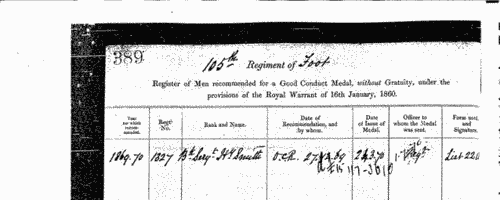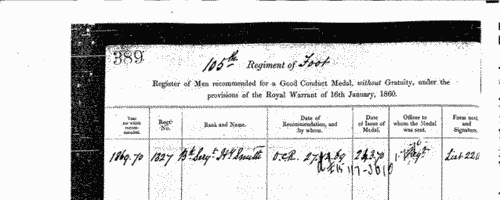Add this eBook to your basket to receive access to all 421 records. Our indexes include entries for the spelling keating. In the period you have requested, we have the following 421 records (displaying 221 to 230): These sample scans are from the original record. You will get scans of the full pages or articles where the surname you searched for has been found. Your web browser may prevent the sample windows from opening; in this case please change your browser settings to allow pop-up windows from this site. Residents and Traders in Birmingham
(1861)
William Cornish's Corporation General and Trades Directory covered Birmingham, Coventry and the towns of the Black Country. The Birmingham section contains both street lists and this general alphabetical directory. | Sample scan, click to enlarge

| Carpenters Excluded from the Union: Brighton
(1865)
Each annual report of the Amalgamated Society of Carpenters and Joiners included a list of excluded members, arranged by branch. The great majority of the exclusions were for non-payment of entrance money or arrears, but other reasons are cited from time to time - fraud; bringing the society into discredit; dishonesty; entering the society under false pretences; working contrary to the society's interest; not being a competent workman. In most cases names are given in full.
| Sample scan, click to enlarge

| Dublin Electors
(1865)
This alphabetical list of electors for the City of Dublin for 1865 is annotated with details of the votes cast in the election of 15 July 1865 for a member of Parliament. The candidates were John Vance, Esq., D. L. (V), Benjamin Lee Guinness, Esq., D. L., LL. D. (G), and Jonathan Pim, Esq. (P). The first column gives, in bold, the initial of the ward in which lay the property that was the elector's qualification. The second column gives the elector's sequential number (alphabetically) within that ward. Then the elector's full name is given, surname first, and address, usually including house number. The votes cast are shown on the right: where these columns are blank, the elector did not vote. The key to the ward names is: A, South Dock; B, Donnybrook; C, Rathdown; D, Trinity; E, South City; F, Royal Exchange; G, Mansion House; H, Fitzwilliam; I, Wood Quay; K, Merchants' Quay; L, Usher's Quay; M, Arran Quay; N, Inns' Quay; O, North City; P, Rotundo; Q, Mountjoy; R; North Dock. S indicates the register of freemen. | Sample scan, click to enlarge

| East Kent Registered Electors: Minster in Sheppey
(1865)
The poll for two knights of the shire to represent the Eastern Division of the county of Kent in parliament was taken 18 July 1865, the candidates being Sir Edward Cholmeley Dering, bart., (D), Sir Brook William Bridges, bart., (B), and Sir Norton Joseph Knatchbull, bart., (K). This poll book lists all registered electors, whether they voted or not, by electoral district (Ashford, Canterbury, Dover, Faversham, Hythe, Margate, Ramsgate, Romney, Sandwich, Sheerness, Sittingbourne, Whitstable and Wingham) and then by township or parish within which lay the property whereby the electors had qualified. The lefthand column gives sequential number in the whole volume; then follows the elector's full name, surname first, and his address (often elsewhere); and on the righthand side for whom he voted. When the elector was qualified in duplicate the vote is recorded opposite to the number upon which he claimed to vote at the polling booth, and wherever his name occurs elsewhere a reference is made, immediately after the address, to the number where his vote is recorded, with the initials of the candidates for whom he voted. Duplicate voters who were dead at the time of the election, or did not vote, are printed in italics to signify that they did not vote, or are stated to be dead once only; and wherever the names of such electors occur elsewhere references are made to the numbers where alone they are reckoned in the abstract of the poll as dead or not voting. Whenever a number only, without any other reference, follows the address, it denotes that at the number referred to, the elector is entered as not voting. | Sample scan, click to enlarge

| London Members of the Pharmaceutical Society
(1865)
The annual list of Members, Associates and Apprentices of the Pharmaceutical Society of Great Britain includes lists of London Members and Country Members (giving year of membership, number of certificate (if any), full name (surname first), and address: an asterisk indicates a Life Member); Associates admitted before 1 July 1842 (with full name, and where registered); Associates of the Society who had passed the Major Examination and were registered as Pharmaceutical Chemists, and Associates of the Society who had passed the Minor Examination and were registered as Assistants (year of admission, number of certificate, full name, and where registered); and Registered Apprentices (with date of registration, full name, residing with, and town).
| Sample scan, click to enlarge

| Dublin University Electors
(1868)
The roll of all persons entitled to vote at elections for members to serve in Parliament for the University of Dublin lists living graduates of the university, arranged alphabetically by surname and christian name(s), with current residence, dates at which their degrees were conferred - Vern. denoting the Spring, Aest. the Summer, and Hiem. the Winter Commencements - and date of registration. Members of the Senate and electors on the books of Trinity College are distinguished by a dagger. Where an elector's name is given in italics, he was no longer known at the residence given. | Sample scan, click to enlarge

| Unclaimed Money and Property
(1868)
Gun & Co. of 6 Prince of Wales' Road, London, in about 1868 published this third 'List of Next of Kin & Heirs, &c., who have been Advertised for in the English, Irish, Scotch, United States of America, Canadian, Australian, East and West Indian, and other Newspapers, since 1704. Money & Property to the value of many Millions Sterling want Claimants'. The list of 4,128 names gives surname, christian name, and, occasionally, locality. Copies of the actual advertisements were furnished to enquirers by the company at a cost of six shillings. | Sample scan, click to enlarge

| Deaths
(1869)
Deaths reported in the Pall Mall Gazette, May 1869 | Sample scan, click to enlarge

|  Outstanding soldiers of the 100th regiment of Foot
(1860-1870) Outstanding soldiers of the 100th regiment of Foot
(1860-1870)
The 100th (The Prince of Wales' Royal Canadian) Regiment of Foot was raised in Canada in 1858, and proceeded to England; embarked for Gibraltar in 1859; went to Malta in 1863; to Canada in 1866; and to Scotland in 1868. It returned to England in 1869: the regimental depot was on the Isle of Wight. Each year just a handful of outstanding soldiers of the regiment were chosen for good conduct medals and gratuities: these are listed here. There were two lists, one for men recommended for the Good Conduct Medal without a gratuity, and one for gratuities - £5 to a private, £10 to a corporal, and £15 to a serjeant. Both lists are indexed here, and each gives rank, name, regimental number, date of recommendation and date of issue. (The sample scan is from the 105th foot) | Sample scan, click to enlarge

|  Outstanding soldiers of the 13th regiment of Foot
(1860-1870) Outstanding soldiers of the 13th regiment of Foot
(1860-1870)
The 13th, or Prince Albert's Regiment of Light Infantry was in two battalions. The 1st battalion embarked for Gibraltar in 1851, and served successively in the Crimea, at the Cape of Good Hope, and in India (1857 to 1864, being based at Gorruckpore). The home depot was at Fermoy in Ireland. Having returned to England in 1864, the battalion was moved to Ireland in 1866, and to Gibraltar in 1867. The second battalion was also based at Fermoy, but embarked for the Cape in 1859, thence to Mauritius in 1863, and back to England in 1867. Each year just a handful of outstanding soldiers of the regiment were chosen for good conduct medals and gratuities: these are listed here. There were two lists, one for men recommended for the Good Conduct Medal without a gratuity, and one for gratuities - £5 to a private, £10 to a corporal, and £15 to a serjeant. Both lists are indexed here, and each gives rank, name, regimental number, date of recommendation and date of issue. (The sample scan is from the 105th foot) | Sample scan, click to enlarge

|
Research your ancestry, family history, genealogy and one-name study by direct access to original records and archives indexed by surname.
|












